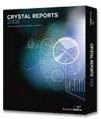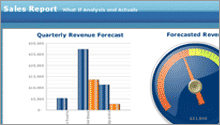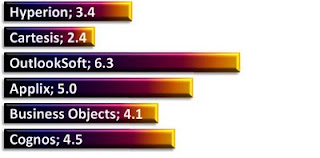
Crystal Reports 2008 has now unleashed some new powerful and dynamic reporting features not previously seen in a reporting product. We have taken Crystal Reports 2008 for a test drive and we believe "this release has the potential to transform every business user's working environment". Business Objects a provider of business intelligence (BI) solutions, launched Crystal Reports 2008. Reports are the lifeblood of communication between people, business, partners, and customers. Crystal Reports is now fifteen years old. Crystal Reports 2008 continues to provide innovation for both new and existing customers. Crystal Reports 2008 delivers actionable data for any organization with a comprehensive set of new features for business users, report designers and application developers.
Juliette Sultan, Vice President of Information Discovery and Delivery at Business Objects says
"Crystal Reports 2008 brings excitement into reporting. With this release we are addressing the needs of both the report designers and the consumers of the reports. The reaction from our beta customers and partners has been overwhelmingly positive. People are telling us that the game-changing Crystal Reports 2008 has the power to transform decision-making and improve careers."
The release of Crystal Reports 2008 has definitely redefined the reporting experience. Some of the new features include:
• Flexible, interactive report viewing
• Advanced report designer
• More professional looking and persuasive reports
• Comprehensive set of deployment options
• Reduced report proliferation and maintenance
• Reduced design time
• improved designer productivity
Crystal Reports 2008 delivers advanced functionality to help build powerful reports, reduce report proliferation and maintenance, and save time with high-productivity design features. New interactive features include in-report sorting, reformatting and parameter filtering. You can now create visually compelling data presentations by easily embedding Xcelsius and Flash elements. You can save time by adding summary, variance and any other custom calculation into a crosstab row or column without any coding.
1. Xcelsius Integration

What-if scenario like models allow you to visualise the potential outcome of your business decisions and can be built into your reports. Import Xcelsius-generated SWF files into your report and benefit from improved design-time integration. IT and developers will design fewer reports to support the decision making process. Please note: Xcelsius design tool is not included in Crystal Reports 2008.
2. Interactive Report Viewing
Business users can determine answer more business questions with fewer, more flexible reports – significantly reducing Developer and IT support dependency. On-report sorting, filtering, and report reformatting with the .NET Winform, and .NET Webform viewers allows users to explore information interactively without re-querying the database. New optional parameters provide for complex user-driven filtering scenarios.
3. Powerful Crosstabs
Add business-critical information to your reports without coding. Summary, variance, and any other customer calculations can be inserted into a crosstab row or a column – especially useful for reports that benefit from a table structure such as financial reports. The crosstab table structure makes reports much faster to build and maintain. This feature also provides powerful benefits to crosstab-based charts since custom formulas in the crosstab can be visualized within the charts.
4. Advanced Report Publishing
Expand your IT capability and deliver a better customer experience. Also known as report bursting, advanced report publishing is a platform for the mass distribution of personalized content. Multiple reports can be created based on different data sources, combined into one desired file format (such as PDF), loaded with personalized content, and then sent to a dynamic list of recipients—with a single action. The content can be archived, printed, or emailed in separate actions, or simultaneously. This makes scheduling much faster and easier, with the ability to conduct cost effective one-on-one marketing campaigns and other personalized high-volume reporting.
The salesforce.com driver included with Crystal Reports 2008 allows for easy access to complete customer data - turning it into actionable business information. Reports that use a salesforce.com driver will refresh when deployed to crystalreports.com.
6. Improved XML Support
Render reports in almost any format and enjoy faster and easier integration with your industry-specific business processes—without any custom coding. The XSLT transformations are embedded into the report file and will be triggered by users from within the viewer when exporting to XML. This provides a powerful, flexible hook for transforming Crystal Reports data and integrating it into other applications.
7. Advanced Paging
Facilitate better online report viewing to your end users. Report designers can customize page size and easily control page breaking after N records/groups. A single report can combine portrait and landscape oriented pages and the white space at the end of groups can be removed by compressing the page footers. Online report consumption is improved because reports are easier to read.
8. Adobe Flash & Flex Integration

Execute business decisions from within the report file. Integrate your reports with operational workflows by embedding Adobe Flex (SWF) applications into your reports. Using Adobe Flex Builder you can create any business-user UI to access report data and integrate with external web services. Data in your report can be passed to the Flex application via Flashvars, making it easy to create a flexible UI even when you don't have access to your data via web services. The Flex applications can do tasks like database write-back - invoking operational workflows directly within Crystal Reports. IT and Developers benefit from instant, coding-free integration of Crystal Reports with your business processes. Please note: Adobe Flex Builder is not included in Crystal Reports 2008.
You can create stunning visualisations with dynamic charts, graphics and video to your reports. A variety of flexible data presentation options are included via Flash. Flash (SWF) files can be integrated into a report, providing interactive and information-rich reports. Flash files can be easily embedded in a report or linked via a website avoiding the need for IT and development time.
 Following on from my post of Business Intelligence Vendor consolidation, the price paid for these acquisitions and mergers has come under scrutiny. During Spring 2007, three takeovers of performance management competitors occurred almost simultaneously. The SAP takeover of Business Objects was announced on October 7, and IBM’s takeover of Cognos on November 12.
Following on from my post of Business Intelligence Vendor consolidation, the price paid for these acquisitions and mergers has come under scrutiny. During Spring 2007, three takeovers of performance management competitors occurred almost simultaneously. The SAP takeover of Business Objects was announced on October 7, and IBM’s takeover of Cognos on November 12.







